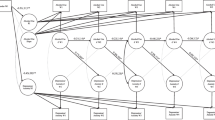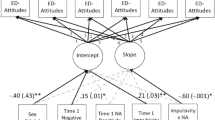Abstract
This investigation examined potential moderators of the longitudinal relation between negative affectivity and drinking. Specifically tested was the degree to which alcohol expectancies and coping styles moderate the relation between negative affectivity in early adolescence and drinking in middle and late adolescence. Four hundred ninety nine early adolescents completed inventories of negative affectivity, coping style, and tension reduction expectancies, and were followed up with inventories of drinking in middle and late adolescence. Constructive coping moderated the relation between negative affectivity and drinking in middle adolescence, such that only those with poor coping skills exhibited this positive relation. Although early negative affectivity was directly related to drinking in late adolescence, no interactions between negative affectivity and expectancies or coping were detected for drinking at that age. This absence of consistent moderating effects indicates significant limitations in the ability of the traditionally-conceived affect regulation model to reliably predict adolescent drinking.

Similar content being viewed by others
References
Aiken, L. S., & West, S. G. (1991). Multiple regression: Testing and interpreting interactions. Newbury Park, CA.: Sage.
Annis, H. M., Graham, J. M., & Davis, C. S. (1987). Inventory of drinking situations (IDS): User’s guide. Toronto: Addiction Research Foundation.
Bandura, A. (1977). Social learning theory. Englewood Cliffs, NJ: Prentice-Hall.
Baumeister, R. F., & Heatherington, T. F. (1996). Self-regulation failure: An overview. Psychological Inquiry, 7, 1–15.
Caprara, G. V. (1983). La misura dell’aggressivita: Contributoo di ricerca per la costruzione e la validazione di due scale per la misura dell’ irritabilita e della suscettibilita emotive. Genital. Psicologia., 9, 91–111.
Caprara, G. V., Barbaranelli, C., Pastorelli, C., & Perugini, M. (1994). Individual differences in the study of human aggression. Aggressive Behavior, 20, 291–303.
Caprara, G. V., Cinanni, V., D’Imperio, G., Passerini, S., Renzi, P., & Travaglia, G. (1985). Indicators of impulsive aggression: Present status of research on irritability and emotional susceptibility scales. Personality and Individual Differences, 6, 665–674.
Chassin, L., Curran, P. J., Hussong, A. M., & Colder, C. R. (1996). The relation of parent alcoholism to adolescent substance use: a longitudinal follow-up study. Journal of Abnormal Psychology, 105, 70–80.
Christiansen, B. A., Goldman, M. S., & Inn, A. (1982). Development of alcohol-related expectancies in adolescents: Separating pharmacological from social-learning influences. Journal of Consulting and Clinical Psychology, 50, 336–344.
Christiansen, B. A., Smith, G. T., Roehling, P. V., & Goldman, M. S. (1989). Using expectancies to predict adolescent drinking behavior after one year. Journal of Consulting andt Clinical Psychology, 57, 93–99.
Colder, C. R. (2001). Life stress, physiological and subjective indexes of negative emotionality, and coping reasons for drinking: is there evidence for a self-medication model of alcohol use? Psychology of Addictive Behaviors, 15, 237–245.
Colder, C. R., & Chassin, L. (1993). The stress and negative affect model of adolescent alcohol use and the moderating effects of behavioral undercontrol. Journal of Studies on Alcohol, 54, 326–333.
Conger, J. J. (1956). Reinforcement theory and the dynamics of alcoholism. Quarterly Journal of Studies on Alcohol, 13, 296–305.
Cooper, M. L., Frone, M. R., Russell, M., & Mudar, P. (1995). Drinking to regulate positive and negative emotions: A motivational model of alcohol use. Journal of Personality and Social Psychology, 69, 990–1005.
Cox, W. M., & Klinger, E. (1988). A motivational model of alcohol use. Journal of Abnormal Psychology, 97, 168–180.
Dakof, G. A. (2000). Understanding gender differences in adolescent drug abuse: Issues of comorbidity and family functioning. Journal of Psychoactive Drugs, 32, 25–32.
Hollingshead, A. B. (1975). Four factor index of social status. New Haven, CN: Department of Sociology, Yale University.
Hussong, A. M., & Chassin, L. (1994). The stress-negative affect model of adolescent alcohol use: Disaggregating negative affect. Journal of Studies on Alcohol, 55, 707–718.
Hussong, A. M., Curran, P. J., & Chassin, L. (1998). Pathways of risk for accelerated heavy alcohol use among adolescent children of alcoholic parents. Journal of Abnormal Child Psychology, 26, 453–466.
Johnson, L. D., O’Malley, P. M., & Bachman, J. G. (2003). Monitoring the future national results on adolescent drug use: Overview of key findings, 2002 (NIH Publication No. 03-5374). Bethesda, MD: National Institute on Drug Abuse.
Krueger, R. F., Schmutte, P. S., Caspi, A., Moffitt, T. E., Campbell, K., & Silva, P. A. (1994). Personality traits are linked to crime among men and women: Evidence from a birth cohort. Journal of Abnormal Psychology, 103, 328–338.
Labouvie, E. W., Pandina, R. J., White, H. R., & Johnson, V. (1990). Risk factors of adolescent drug use: An affect-based interpretation. Journal of Substance Abuse, 2, 265–285.
Laurent, J., Catanzaro, S. J., & Callan, M. K. (1997). Stress, alcohol-related expectancies and coping preferences: A replication with adolescents of the Cooper et al. (1992) model. Journal of Studies on Alcohol, 58, 644–651.
MacLean, M. J., Paradise, M. J., & Cause, A. M. (1999). Substance use and psychological adjustment in homeless adolescents: A test of three models. American Journal of Community Psychology, 27, 405–427.
Martin, C. S., Lynch, K. G., Pollack, N. K., & Clark, D. B. (2000). Gender differences and similarities in the personality correlates of adolescent alcohol problems. Psychology of Addictive Behaviors, 14, 121–133.
Newcomb, M. D., Chou, C., Bentler, P. M., & Huba, G. J. (1988). Cognitive motivations for drug use among adolescents: Longitudinal tests of gender differences and predictors of change in drug use. Journal of Counseling Psychology, 35, 426–438.
Raimo, E. B., & Schuckit, M. A. (1998). Alcohol dependence and mood disorders. Addictive Behaviors, 23, 933–946.
Russell, J. A., & Mehrabian, A. (1975). The mediating role of emotions in alcohol use. Journal of Studies on Alcohol, 36, 1508–1536.
Shen, S., Locke-Wellman, J., & Hill, S. Y. (2001). Adolescent alcohol expectancies in offspring from families at high risk for developing alcoholism. Journal of Studies on Alcohol, 62, 763–772.
Sher, K. (1994). Individual-level risk factors. In R. Zucker, G. Boyd & J. Howard (Eds.), The development of alcohol problems: exploring the biopsychosocial matrix of risk. NIAAA Research Monograph 26. Rockville, MD: National Institute on Alcohol Abuse and Alcoholism, 1994.
Sher, K. J., & Levenson, R. W. (1982). Risk for alcoholism and individual differences in the stress-response-dampening effect of alcohol. Journal of Abnormal Psychology, 91, 350–367.
Shoal, G. D., & Giancola, P. R. (2001). Cognition, negative affectivity, and substance use in adolescent boys with and without a family history of a substance use disorder. Journal of Studies on Alcohol, 62, 675–686.
Shoal, G. D., & Giancola, P. R. (2003). Negative affectivity and drug use in adolescent boys, moderating and mediating mechanisms. Journal of Personality and Social Psychology, 84, 221–233.
Spielberger, C. D., Gorsuch, R. L., & Lushene, R. E. (1970). Manual for the state-trait anxiety inventory. Palo Alto, CA: Consulting Psychologists Press.
Tarter, R. E. (1990). Evaluation and treatment of adolescent substance abuse: A decision tree method. American Journal of Drug and Alcohol Abuse, 61, 1–46.
Tice, D. M., Bratslavsky, E., & Baumeister, R. F. (2001). Emotional distress takes precedence over impulse control: If you feel bad, do it! Journal of Personality and Social Psychology, 80, 53–67.
Wills, T. A. (1985). Stress, coping and tobacco and alcohol use in early adolescence. In S. Shiffman & T. A. Wills (Eds.), Coping and substance use (pp. 67–94). New York: Academic.
Windle, M., & Barnes, G. M. (1988). Similarities and differences in correlates of alcohol consumption and problem behaviors among male and female adolescents. International Journal of Addictions, 23, 707–728.
Author information
Authors and Affiliations
Corresponding author
Additional information
This research was conducted at the Center for Education and Drug Abuse Research (CEDAR) which is located in the School of Pharmaceutical Sciences at the University of Pittsburgh and is supported by grant P50-DA-05605 from the National Institute on Drug Abuse.
Rights and permissions
About this article
Cite this article
Shoal, G.D., Gudonis, L.C., Giancola, P.R. et al. Negative Affectivity and Drinking in Adolescents: An Examination of Moderators Predicted by Affect Regulation Theory. J Psychopathol Behav Assess 30, 61–70 (2008). https://doi.org/10.1007/s10862-007-9051-3
Published:
Issue Date:
DOI: https://doi.org/10.1007/s10862-007-9051-3




